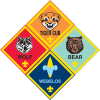
Snap! Fizzle! Goosh! Sploosh! Ooze! Grow! Wow! Do you want to know why we are so excited? It is because science is super! It is super snappy and filled with static! Have you ever wondered if everything will stick to a static-charged balloon? Will static attract water? Science can be super gooshy and splooshy, and grow when you add baking soda, vinegar, and dish detergent! Wow! You may have learned that oil and water don’t mix, but did you know that when you mix oil, water, and food coloring amazingly super things happen? In this adventure, we are going to explore why science is so super!
Rationale for Adventure
In this adventure, Bear Scouts will get a little messy but gain a lot of knowledge. Science is an everyday wonder that Scouts an learn more about by simply using ordinary household supplies. Their actions will create amazing reactions in fun investigations exploring static electricity, oil and water, sinking vs floating, and color morphing and layering.
Requirements
Complete at least four of the following:
- Make static electricity by rubbing a balloon or a plastic or rubber comb on a fleece blanket or wool sweater. Explain what you learned.
- Conduct one other static electricity investigation. Explain what you learned.
- Do a sink-or-float investigation. Explain what you learned.
- Do a color-morphing investigation. Explain what you learned.
- Do a color-layering investigation. Explain what you learned.
Takeaways for Cub Scouts
- Following directions
- Introduction to the scientific method
- Learning the scientific law of action and reaction
- Finding new ways to be creative
Historical Requirements
2015 Handbook Requirements
Bear Handbook, page 266
Bear Den Leader Guide, page 175
- Make static electricity by rubbing a balloon or a plastic or rubber comb on a fleece blanket or wool sweater. Explain what you learned.
- Conduct a balloon or other static electricity investigation that demonstrates properties of static electricity. Explain what you learned.
- Conduct one other static electricity investigation. Explain what you learned.
- Do a sink-or-float investigation. Explain what you learned.
- Do a color-morphing investigation. Explain what you learned.
- Do a color-layering investigation. Explain what you learned.






